Titanic in The Literary Digest: A Media Reflection on Tragedy, Reform, and Remembrance (1912)
📌 Explore rare Titanic images from The Literary Digest, including survivor photos, political cartoons, safety reform proposals, and official investigations. A valuable historical resource for researchers, students, and maritime enthusiasts.
Images pertaining to the Titanic disaster or its aftermath, published in The Literary Digest, an influential American general interest weekly magazine published by Funk & Wagnalls. All their material is condensed from other periodicals or from books with extensive use of news photographs. Founded by Isaac Kaufmann Funk in 1890, it eventually merged with two similar weekly magazines, Public Opinion and Current Opinion. It ceased publication in 1938.
Titanic Images - The Literary Digest 🚢📰
Review: A Visual Chronicle of the Titanic Disaster in Media History
The Literary Digest, an influential American weekly magazine, captured the public reaction, survivor accounts, and aftermath of the Titanic disaster through photographs, illustrations, and political cartoons. This collection from The Literary Digest provides a powerful, multi-faceted historical account, drawing from newspapers, periodicals, and official reports in the months following the sinking.
🔹 Why This Collection is Significant for Educators, Historians, and Genealogists:
🔹 Comprehensive Coverage – The images document the ship’s final voyage, key figures, political scrutiny, and safety reforms.
🔹 Political Cartoons & Public Response – The editorial cartoons provide a rare insight into public opinion, criticism of maritime practices, and lessons learned.
🔹 Genealogical & Biographical Value – Features notable Titanic passengers, survivors, and rescuers, useful for family researchers.
🔹 Engineering & Safety Reform – Includes diagrams on lifeboat modifications, ship design improvements, and iceberg avoidance strategies.
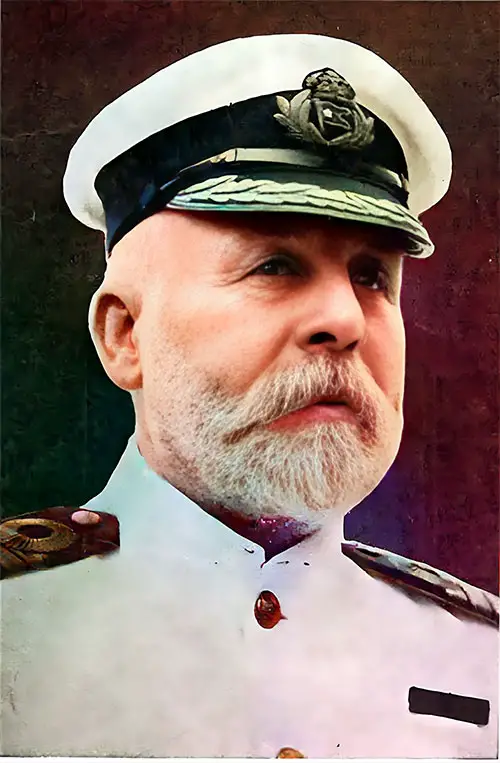
Captain Edward John Smith Who Went Down with His Ship. The Literary Digest, 27 April 1912. GGA Image ID # 1084643a7b
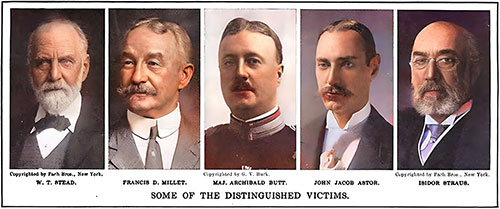
Some of the Distinguished Victims: W. T. Stead, Francis D. Millet, Major Archibald Butt, John Jacob Astor, and Isidor Straus. The Literary Digest, 27 April 1912. GGA Image ID # 1084a54b26
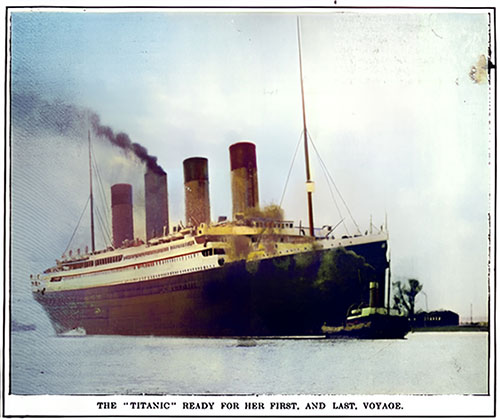
The RMS Titanic Ready for Her First, and Last, Voyage. The Literary Digest, 27 April 1912. GGA Image ID # 1084c9f3c4
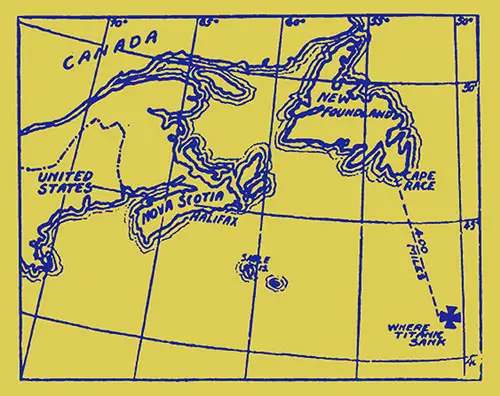
Map Showing the Location Where the RMS Titanic Sank. The Literary Digest, 27 April 1912. GGA Image ID # 1084cab48c
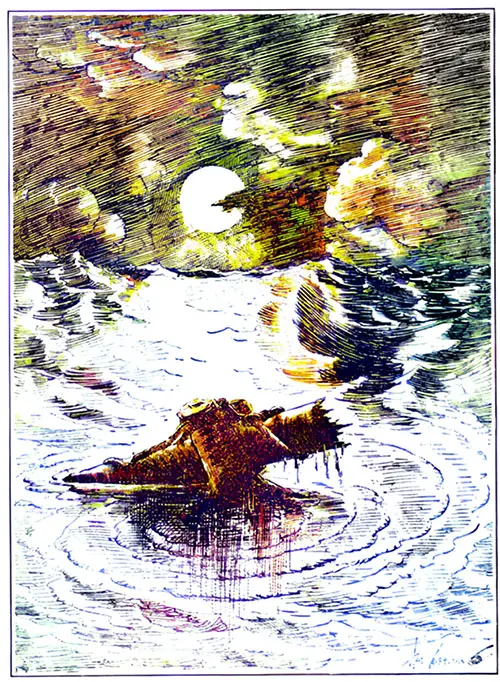
Titanic Political Cartoon. "Unsinkable" Drawn by Coffman. Published in the New York Journal. The Literary Digest, 27 April 1912. GGA Image ID # 1085409260
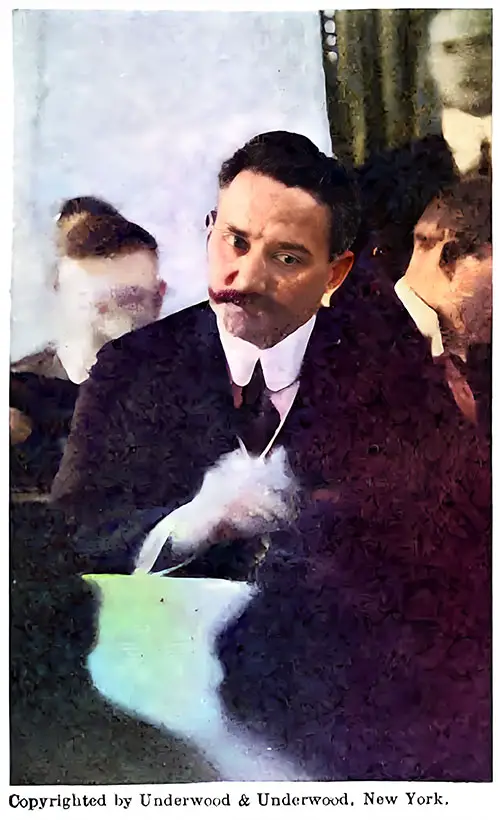
Mr. Joseph Bruce Ismay - President of the International Mercantile Marine Company. testifying before the committee of investigation. He declares the wreck of the Titanic has taught him a lesson. © Underwood & Underwood. The Literary Digest, 4 May 1912. GGA Image ID # 103a71ff4f
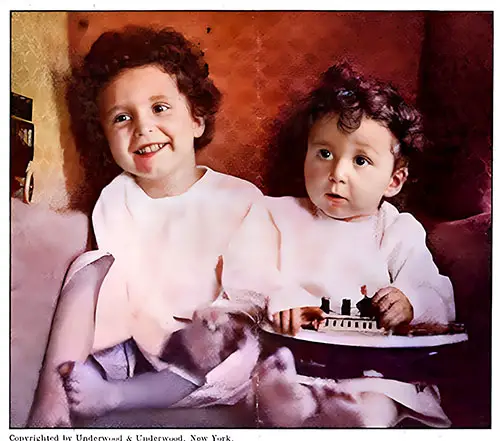
Two Little Waifs from the “Titanic.” “Lolo‘* and “Mono,“ who were placed in a life-boat by a man who stayed on the ship. A Mme. Navratll. of Nice. France, is coming to claim them as hers. Many offers of adoption have come to Miss Margaret Hays, who has been caring for them. © Underwood & Underwood. The Literary Digest, 4 May 1912. GGA Image ID # 1085791367
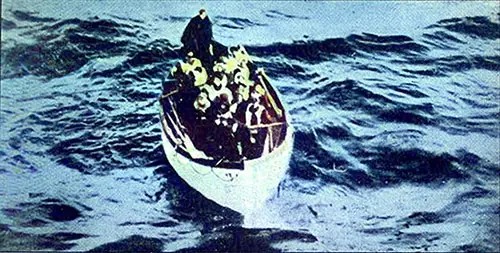
One of the "Titanic's" Life-Boats Approaching the “Carpathia,” Barely Half Full. © Underwood & Underwood. The Literary Digest, 4 May 1912. GGA Image ID # 1085e15b3a

Two Widows and Their Children. Steerage Survivors Who Will Find the Relief Fund a Godsend. © Underwood & Underwood. The Literary Digest, 4 May 1912. GGA Image ID # 10867a42f9
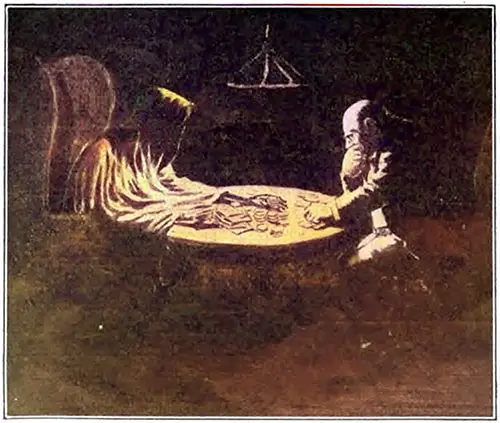
Titanic Political Cartoon. The Steamship-Owner Gambled with Death - but Death Held the Cards —Barclay in the Baltimore Sun. The Literary Digest, 4 May 1912. GGA Image ID # 103c61ea80
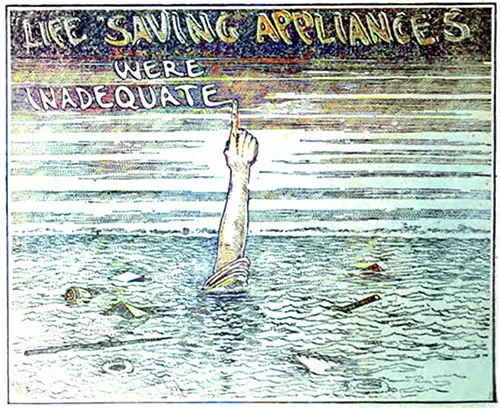
Titanic Political Cartoon. “The Moving Finger Writes, And. Having Writ, Moves On." (Life Saving Appliances Were Inadequate —Ireland lo the Columbus Dispatch. The Literary Digest, 4 May 1912. GGA Image ID # 103c9aff7e
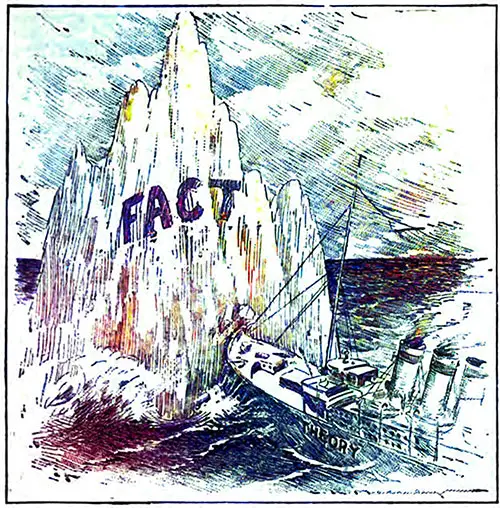
Titanic Political Cartoon. The Eternal Collision —Macauley in the New York World. The Literary Digest, 4 May 1912. GGA Image iD # 103ac3fcc9

Titanic Political Cartoon. The Helmsman, Speed Mania. Drawn by Johnson. Published in the Philadelphia North American. The Literary Digest, 4 May 1912. GGA Image ID # 103a800831
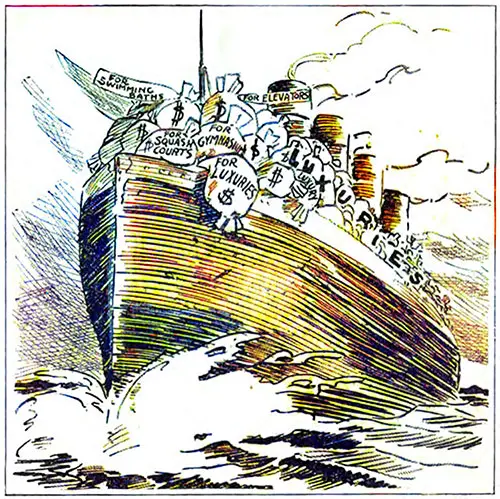
Titanic Political Cartoon. Luxuries of Modern Travel -- But Not Enough Lifeboats. Published in the Montreal Herald. The Literary Digest, 4 May 1912. GGA Image ID # 10868883f9
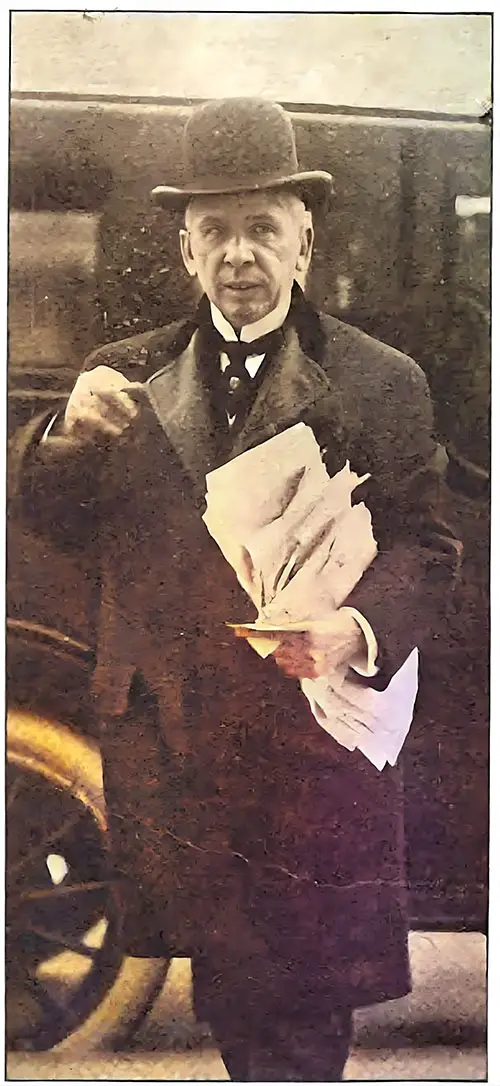
Senator William Alden Smith. Arriving at the Senate Office Building in Washington to Question the Surviving Officers and Crew of the Titanic. © C. V. Buck, Washington. The Literary Digest, 11 May 1912. GGA Image ID # 10868a33ae
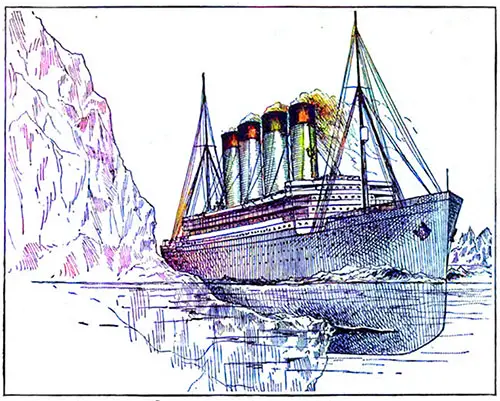
Illustration of the Titanic Scraping the Iceberg: What Really Happened? According to the Scientific American, When the Titanic Collided With the Iceberg, It Likely Struck a Massive, Projecting Underwater Shelf. This Impact Tore Open Several Compartments of the Ship, With the Damage Extending From Near the Bow to Amidships. the Energy Released During the Collision Was Estimated to Be 1,161,000 Foot-Tons, Which Is Comparable to the Combined Firepower of the Battleships Delaware and North Dakota. Illustration from the Scientific American. The Literary Digest, 11 May 1912. GGA Image ID # 10869441df

How Lifeboats For All Could Be Carried. On the Left, Boat Deck of the Titanic Showing 20 Lifeboats Carrying About 1,000 Passengers. On the Right, Plan of Boat Deck Showing Suggested Accommodations for 56 Boats Carrying About 3,100 Passengers. Illustration from the Scientific American. The Literary Digest, 11 May 1912. GGA Image ID # 1086a1115f
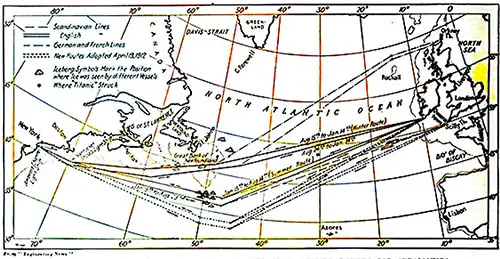
Chart of the North Atlantic Showing the New Summer Routes for Steamships. Inter Routes of German and French Lines Are Not Shown. the Turning Points Are the Same as for the English Lines. These Points Are Indicated by Small Open Circles. Position of Icebergs Is Shown by Shaded Spots. Chart From Engineering News. The Literary Digest, 11 May 1912. GGA Image ID # 1086b494ee
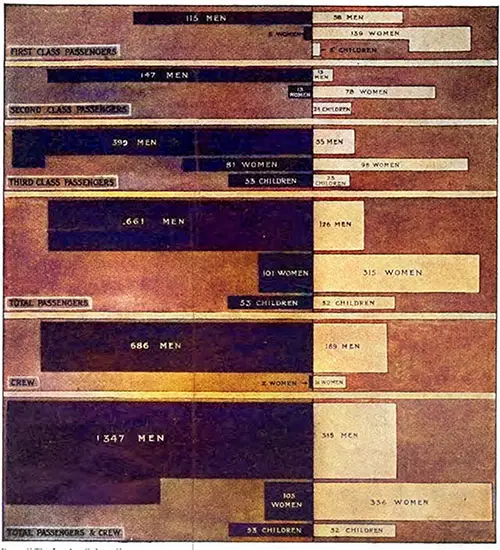
Results of the Titanic Disaster Analyzed. from Official Figures Given in the House of Commons. The Black Indicates Passengers and Crew Lost, and the White Indicates the Saved. Illustration from The London Sphere. The Literary Digest, 25 May 1912. GGA Image ID # 1086c6ddfa
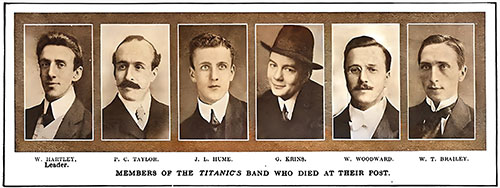
Members of the Titanic's Band Who Died at Their Post: W. Hartley, Leader; P. C. Taylor, J. L. Hume, G. Krine, W. Woodward, and W. T. Brailey. The Literary Digest, 25 May 1912. GGA Image ID # 10872e2ac0

A Piece of Documentary Evidence. Facsimile of one of the seven checks said to have been given by Sir Cosmo Duff- Gordon to the crew of the life-boat in which he was saved from the Titanic. The charge is made that this life-boat left the ship early with a few rich passengers. It was called “the millionaires’ special” by the other survivors. Document from "Newspaper Illustrations," London. The Literary Digest, 25 May 1912. GGA Image ID # 1087436e11

A Life-Raft to Form Part of the Deck. This device proposed by the London Sphere would be part of the deck ordinarily, but in case of wreck it would float oft as a raft holding hundreds of the passengers and crew. Illustration from the London Sphere. The Literary Digest, 25 May 1912. GGA Image ID # 1087a33f99

A Route That Will Defy The Icebergs. The Proposed Hudson Bay Route to Europe. Dotted with Bcrgs and Shrouded in Fog. Map from the Engineering News. The Literary Digest, 25 May 1912. GGA Image ID # 10881b7ac3

Folding Lifeboats on the Olympic. This type may be constructed much more strongly than the collapsible boats on the next page and may be launched from Davits, as shown. Photos from Motor Boating, New York. The Literary Digest, 22 June 1912. GGA Image ID # 10883bc9d4
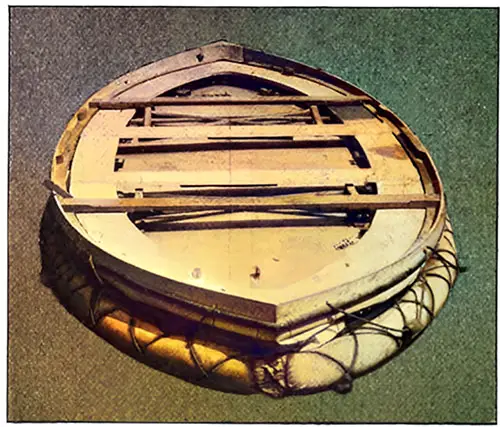
A Collapsible Boat of the Kind Used on the Titanic. The bottom is of wood and the sides are canvas. Photo from Motor Boating, New York. The Literary Digest, 22 June 1912. GGA Image ID # 108848707b
s
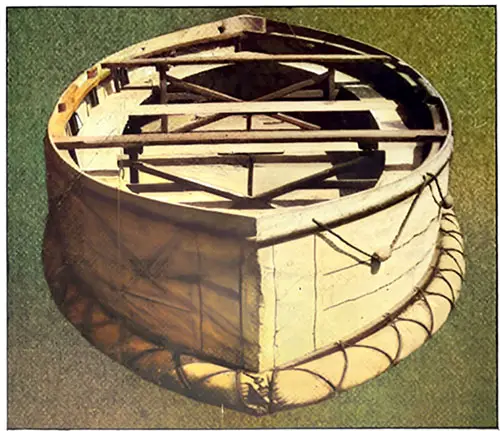
The Collapsible Lifeboat When in Use. The cross members swing down to keep the boat extended. The large cork-filled fenders will support the crew if the boat capsizes. Photo from Motor Boating, New York. The Literary Digest, 22 June 1912. GGA Image ID # 10887703c2
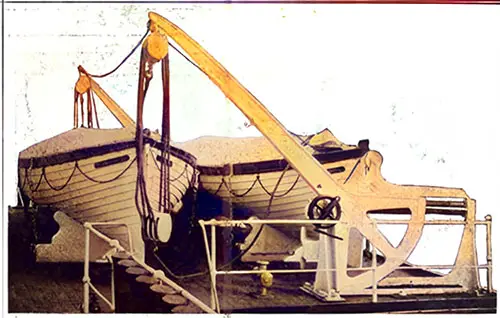
Old Life-Boat Davits Made Obsolete. The Welin davit greatly facilitates the launching of lifeboats, as they are swung clear of the ship's side by merely turning a crank. Although equipped with these davits, the Titanic had but one boat to each set, whereas she might have had two. As shown here. Photo from Motor Boating, New York. The Literary Digest, 22 June 1912. GGA Image ID # 1088b358b2
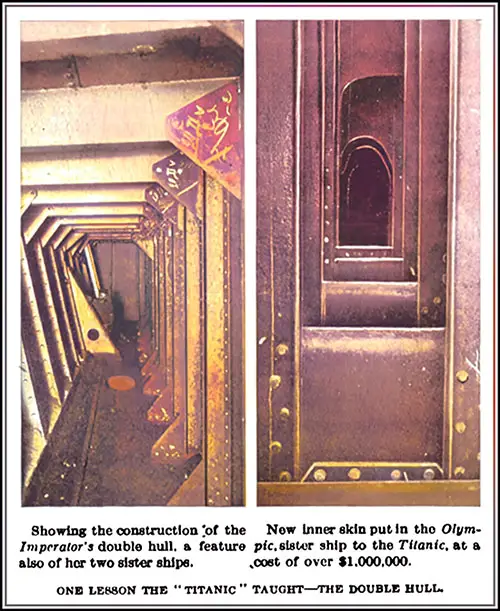
One Lesson The Titanic Taught -- The Double Hull. On the left, showing the construction of the Imperator's double hull, a feature also of her two sister ships. On the right, new inner skin put in the Olympic, sister ship to the Titanic, at a cost of over $1,000,000. The Literary Digest, 26 June 1912. GGA Image ID # 1088bb8198
Key Highlights and Most Engaging Content
📍 Captain Edward J. Smith: A Symbol of Leadership and Loss 👨✈️⚓
🔹 A haunting portrait of Titanic’s captain, who chose to go down with his ship.
🔹 A compelling discussion point on maritime command responsibilities and leadership under crisis.
📍 Distinguished Victims: A Snapshot of the Titanic’s Elite Passengers 🏛️💼
🔹 This collage of notable figures lost, including W.T. Stead, Francis Millet, Major Archibald Butt, John Jacob Astor, and Isidor Straus, illustrates the Titanic’s social diversity and its high-profile losses.
🔹 Encourages discussions on wealth, privilege, and survival disparities during the evacuation.
📍 The RMS Titanic Ready for Her First, and Last, Voyage 🚢
🔹 A stirring image of Titanic before departure, symbolizing both human ambition and tragedy.
🔹 Ideal for exploring maritime advancements, Edwardian travel, and the myth of the "unsinkable" ship.
📍 Map Showing the Location Where the RMS Titanic Sank 🌎
🔹 A geographical representation of the disaster’s exact coordinates helps visualize the rescue and search efforts.
🔹 Useful for maritime navigation and oceanic history discussions.
📍 Political Cartoon: “Unsinkable” by Coffman (New York Journal) 🎭
🔹 A darkly ironic take on the Titanic’s overconfidence, warning against arrogance in technological progress.
🔹 Great for analyzing early 20th-century media satire and public sentiment.
📍 J. Bruce Ismay Testifies Before the Senate Inquiry ⚖️
🔹 As the President of the International Mercantile Marine Company, Ismay faced intense scrutiny for surviving while others perished.
🔹 Raises ethical questions on leadership, corporate responsibility, and survival guilt.
📍 Titanic Orphans: The Navratil Brothers (“Lolo” & “Mono”) 🧒💔
🔹 A deeply moving photograph of two young survivors, whose father placed them in a lifeboat before perishing.
🔹 A powerful discussion point on the human cost of maritime disasters and family separations.
📍 Titanic’s Lifeboat Approaching the Carpathia – Barely Half Full 🚣♂️
🔹 This infamous image reveals the tragic inefficiency of Titanic’s lifeboat evacuation, where lifeboats left partially filled while over a thousand people drowned.
🔹 Crucial for maritime safety studies and ethical discussions on evacuation protocols.
📍 Political Cartoon: “The Steamship-Owner Gambled with Death – but Death Held the Cards” ♠️
🔹 A harsh critique of White Star Line’s prioritization of speed over safety.
🔹 Encourages students to explore the consequences of corporate negligence.
📍 Diagram of the Titanic Scraping an Iceberg: What Really Happened? 🧊📉
🔹 A scientific illustration from The Scientific American, explaining how an underwater shelf of ice tore open Titanic’s hull.
🔹 Useful for physics, engineering, and ship design analysis.
📍 How Lifeboats for All Could Have Been Carried 🚤
🔹 A side-by-side comparison of Titanic’s original lifeboat capacity (20 boats, 1,000 people) versus an improved design (56 boats, 3,100 people).
🔹 Demonstrates how simple changes could have saved hundreds of lives.
📍 Chart of the North Atlantic Showing New Summer Shipping Routes 🌊
🔹 After Titanic, shipping lanes were adjusted to avoid iceberg danger zones.
🔹 A practical example of how maritime disasters lead to global policy changes.
📍 The Titanic’s Band: Heroes Who Played Until the End 🎻
🔹 A somber tribute to Titanic’s musicians, who played Nearer, My God, to Thee as the ship sank.
🔹 A poignant example of duty, bravery, and human spirit in times of crisis.
📍 Sir Cosmo Duff-Gordon’s Controversial Check to Lifeboat Crew 💰
🔹 A facsimile of the alleged “bribe” paid to crew members, who departed early with an underfilled lifeboat.
🔹 Sparks ethical debates on class privilege and survival ethics.
📍 A Life-Raft That Could Form Part of the Ship’s Deck 🛶
🔹 A fascinating engineering proposal for a raft integrated into the ship’s structure.
🔹 Perfect for discussions on post-Titanic safety innovations.
📍 A Proposed Iceberg-Proof Shipping Route Through Hudson Bay ❄️🚢
🔹 A bold yet impractical solution to avoiding icebergs entirely.
🔹 Great for critical thinking on historical problem-solving and risk assessment.
📍 Folding Lifeboats & Collapsible Boats Used on the Titanic ⛵
🔹 A photo study of different lifeboat types, including the collapsible Engelhardt boats used in the final minutes.
🔹 Helps illustrate improvements in maritime safety equipment.
📍 Old Lifeboat Davits vs. The Welin Davit System 🔄
🔹 The Welin davit system could launch two boats per set instead of one, but Titanic only used one per set.
🔹 Demonstrates missed safety opportunities that could have doubled survival rates.
📍 One Lesson the Titanic Taught: The Double Hull 🛳️
🔹 Post-Titanic, ships like Olympic and Imperator were retrofitted with double hulls to prevent similar catastrophes.
🔹 An essential case study in engineering advancements following disaster.
Relevance for Teachers, Students, Historians, and Genealogists 📚
👩🏫 Teachers & Students:
Use primary sources to analyze media influence, political responses, and safety improvements post-Titanic.
Explore themes of heroism, ethics, and social class disparities in maritime disasters.
📜 Historians & Maritime Enthusiasts:
Examines media portrayals of Titanic, providing insight into early 20th-century journalism and public perception.
Essential for maritime policy and engineering research.
🧬 Genealogists:
Features notable figures and survivors, aiding in family history research.
Encouragement to Students 📝
💡 Looking for Essay Inspiration?
Analyze how media shaped Titanic’s legacy in the aftermath of the disaster.
Compare political cartoons of 1912 to modern disaster coverage.
Investigate how Titanic led to major maritime safety reforms.
🔥 Why Use GG Archives?
GG Archives provides authentic, primary-source materials that bring history to life for essays, research projects, and historical inquiry.
🚢 Step back into 1912 and witness Titanic’s tragedy through the eyes of contemporary media. 🌊
